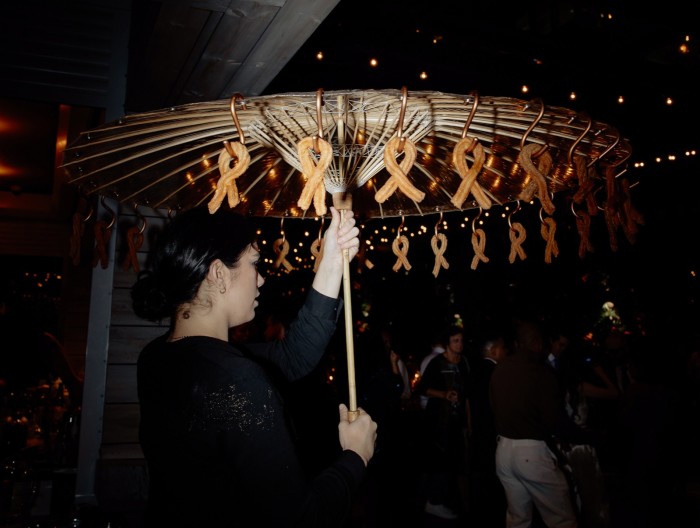The buffet is back. Will you join the queue?

Roula Khalaf, Editor of the FT, selects her favourite stories in this weekly newsletter.
“Buffet” isn’t a word you hear much from top wedding and event caterers any more. Too many stale connotations of slow lines and picked-over salads that don’t exactly say cool. “It makes me think of all-you-can-eat tables groaning under the weight of food wheeled out of a walk-in fridge,” sniffs Bertie de Rougemont of Cellar Society, which caters events for brands and high-net-worth individuals, including Kate Moss’s wedding. And yet buffet-style dining hasn’t gone away. It’s simply been refreshed and refashioned as “activations”, “culinary moments” and “food stations”. These tend to be smaller, more curated, more upscale affairs than broad-church buffets trying to please everyone in one gigantic spread. They’re often more visually inventive and interactive. Though guests can still choose what they want and how much, which gets round issues of dietary requests and picky eaters, and, yes, pasta stations are a must at the wedding party.
Even at formal dinners, floating courses that release guests from the table have become popular. Olivier Cheng’s namesake New York firm looks after weddings, corporate and fashion events such as the Met Gala where it’s near-impossible to get guests to take their seats. “We start serving when half the room is standing,” he reports. “Dinner isn’t long and people don’t stay for dessert. We tend to serve finger food like petits fours that guests can eat on the move.”

Buffet-style events offer various advantages over sit-down dinners, which often require more space and a higher spend on staff and rental costs. During Fashion Week, for example: “The whole minefield of RSVPs, attendance and no-shows is easier to manage with standing events,” says Rougemont. “The last thing a host wants is for guests to leave after the main course and suddenly a load of empty seats appear at their 50-seat dinner.”
At multi-day weddings, secondary events with food stations (such as oyster bars, charcuterie tables or macaroon carts) can be a great alternative to a stuffy sit-down dinner. “Rich people are getting younger and cool people are getting older,” says Carly Katz-Hackman, chief sales officer at Pinch Food Design, a New York caterer known for innovative offerings such as churro umbrellas and pastry “pillows” filled with Greek salad that you smash with a tiny maraca.

Standing events are still capable of delivering prestige service and spectacle. Pinch lays on “tile tables” made up of square plates of tuna, salmon and avocado tartare onto which the chef “live-paints Jackson Pollock‑style” chilli and basil oil and balsamic glaze. During the V&A’s recent Gabrielle Chanel exhibition, London-based caterer Rocket organised a series of corporate events inspired by the show. On marble and linen-covered countertops, chefs carved chateaubriand, mixed tuna tartare and served seafood on ice. The offering allowed guests plenty of time to enjoy the show and made a powerful impression.
For a private event in Kensington Gardens in June, Cellar Society installed a 10m-long feasting table with antique silverware that became “an iPhone feast” for guests, says Rougemont. “The table was meant to be something you’d find at an old English country house where the wife was French.” The food included two wild smoked salmon and a whole Brie de Meaux Donge infused with truffle and served on sourdough with walnuts that “was one of the naughtiest things you’ve ever eaten”.

Unlike buffets, which are usually single-sided, these feasting tables are 360-degree affairs in the middle of a room. “It’s not a canteen experience,” says Rougemont. “You can hang around that table, engage in conversation and the chefs are on the side with the guests.” Focus is also put on “the majesty of specific ingredients. For example, a gorgonzola cremificato spooned by the chef on to melba toast with truffle honey.”
For San Francisco-based caterer Paula LeDuc, whose clients include Dropbox, Pinterest and Stanford University, this means showcasing the best local produce, such as lamb sourced from Umpqua Valley farm in southern Oregon or soft-serve made using buffalo milk from Double 8 dairy in Sonoma County and extra-virgin olive oil from McEvoy Ranch in Petaluma. Having an expert chef on hand to field questions makes all the difference, whether they’re a Japanese sushi master or Spanish jamonista. “Guests want to know the name of the cow,” says Rocket director Charlie Grant Peterkin.
The benefit of these out-of-chair experiences – especially at weddings where two families are coming together and strangers meet for the first time – is they help break the ice. “You can look over that food station, lock eyes with someone you’ve never met and have something to talk about,” says Katz-Hackman.

Comments